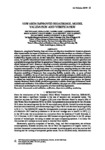TOWARDS IMPROVED BIOAEROSOL MODEL VALIDATION AND VERIFICATION
| dc.contributor.author | WILLIAMS, BEN | |
| dc.contributor.author | HAYES, E | |
| dc.contributor.author | NASIR, Z | |
| dc.contributor.author | ROLPH, C | |
| dc.contributor.author | JACKSON, S | |
| dc.contributor.author | KHERA, S | |
| dc.contributor.author | BENNETT, A | |
| dc.contributor.author | GLADDING, T | |
| dc.contributor.author | DREW, G | |
| dc.contributor.author | LONGHURST, J | |
| dc.contributor.author | TYRREL, S | |
| dc.date.accessioned | 2021-10-05T13:18:25Z | |
| dc.date.available | 2021-10-05T13:18:25Z | |
| dc.date.issued | 2018-06-19 | |
| dc.identifier.issn | 1746-448X | |
| dc.identifier.issn | 1743-3541 | |
| dc.identifier.uri | http://hdl.handle.net/10026.1/17994 | |
| dc.description.abstract |
Bioaerosols, comprised of bacteria, fungi and viruses are ubiquitous in ambient air. Known to adversely affect human health, the impact of bioaerosols on a population often manifests as outbreaks of illnesses such as Legionnaires Disease and Q fever, although the concentrations and environmental conditions in which these impacts occur are not well understood. Bioaerosol concentrations vary from source to source, but specific industrialised human activities such as water treatment, intensive agriculture and open windrow composting facilitate the generation of bioaerosol concentrations many times higher than natural background levels. Bioaerosol sampling is currently undertaken according to the requirements of the Environment Agency's regulatory framework, in which the collection of bioaerosols and not its long-term measurement is of most importance. As a consequence, sampling devices are often moved around site according to changing wind direction and sampling intervals are invariably short-term. The dispersion modelling of bioaerosols from composting facilities typically relies on proxy pollutant parameters. In addition, the use of short term emission data gathering strategies in which monitors are moved frequently with wind direction, do not provide a robust reliable and repeatable dataset by which to validate any modelling or to verify its performance. New sampling methods such as the Spectral Intensity Bioaerosol Sensor (SIBS) provide an opportunity to address several gaps in bioaerosol model validation and verification. In the context of model validation, this paper sets out the current weaknesses in bioaerosol monitoring from the perspective of robust modelling requirements. | |
| dc.format.extent | 41-50 | |
| dc.language.iso | en | |
| dc.publisher | WIT Press | |
| dc.title | TOWARDS IMPROVED BIOAEROSOL MODEL VALIDATION AND VERIFICATION | |
| dc.type | journal-article | |
| dc.type | Journal Article | |
| plymouth.issue | 10 | |
| plymouth.volume | 230 | |
| plymouth.publication-status | Published | |
| plymouth.journal | Air Pollution XXVI | |
| dc.identifier.doi | 10.2495/air180041 | |
| plymouth.organisational-group | /Plymouth | |
| plymouth.organisational-group | /Plymouth/Faculty of Health | |
| plymouth.organisational-group | /Plymouth/Faculty of Health/School of Biomedical Sciences | |
| plymouth.organisational-group | /Plymouth/Research Groups | |
| plymouth.organisational-group | /Plymouth/Research Groups/Institute of Translational and Stratified Medicine (ITSMED) | |
| plymouth.organisational-group | /Plymouth/Research Groups/Institute of Translational and Stratified Medicine (ITSMED)/CBR | |
| plymouth.organisational-group | /Plymouth/Users by role | |
| plymouth.organisational-group | /Plymouth/Users by role/Academics | |
| plymouth.organisational-group | /Plymouth/Users by role/Researchers in ResearchFish submission | |
| dcterms.dateAccepted | 2018-01-01 | |
| dc.rights.embargodate | 2021-10-6 | |
| dc.identifier.eissn | 1743-3541 | |
| dc.rights.embargoperiod | Not known | |
| rioxxterms.versionofrecord | 10.2495/air180041 | |
| rioxxterms.licenseref.uri | http://www.rioxx.net/licenses/all-rights-reserved | |
| rioxxterms.licenseref.startdate | 2018-06-19 | |
| rioxxterms.type | Journal Article/Review |


